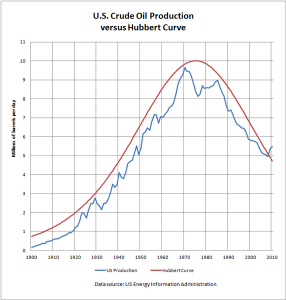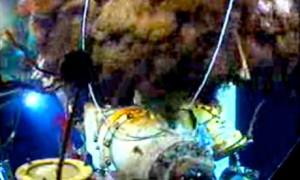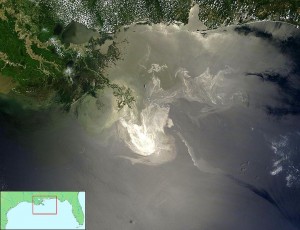My reasons for building electric cars are split into two categories: oil and engineering. We’ll discuss oil first. The two main points here are that oil is running out and our usage and harvesting of it is causing irreparable damage to our planet. I’ll prove it to you.
Hubbert Peak Theory
In 1956, Marion King Hubbert, an American geoscientist, came up with the Peak Oil Production theory. What he figured out was that if you make a graph with time on the X-axis and oil production on the Y-axis, it will look like a bell curve. Oil production started small because we were still developing the techniques for finding and harvesting oil. As  the processes were mastered and the infrastructure built, oil production rose until it peaked in the mid-70’s. It’s no coincidence that the Golden Age of muscle cars was also during the mid-70’s. Oil production then started to decrease as we used up the oil from the high quality, easy to find deposits. In order to keep producing oil, we now have to look harder to find oil deposits of lower quality. More effort and money has to be spent to produce each barrel of oil. From here, the price of oil keeps climbing and supplies keep dwindling until there’s nothing left. US oil production has followed Hubbert’s Theory pretty closely which currently puts us on the back side of the bell curve. That means big companies are starting to go through some pretty ridiculous measures to continue to find oil. Here’s what the future of oil production holds for us all:
the processes were mastered and the infrastructure built, oil production rose until it peaked in the mid-70’s. It’s no coincidence that the Golden Age of muscle cars was also during the mid-70’s. Oil production then started to decrease as we used up the oil from the high quality, easy to find deposits. In order to keep producing oil, we now have to look harder to find oil deposits of lower quality. More effort and money has to be spent to produce each barrel of oil. From here, the price of oil keeps climbing and supplies keep dwindling until there’s nothing left. US oil production has followed Hubbert’s Theory pretty closely which currently puts us on the back side of the bell curve. That means big companies are starting to go through some pretty ridiculous measures to continue to find oil. Here’s what the future of oil production holds for us all:
Ultra-Deepwater Drilling
We’re all at least a little familiar with the problems of ultra-deepwater drilling after the Deepwater Horizon disaster in the Gulf of Mexico in 2010. A simple safety valve failure  resulted in one of the worst accidental oil spills in history because it happened far offshore beneath 5,000 feet of water. The well leaked an estimated 4.9 million barrels of crude oil into the Gulf before it was finally sealed one month later. 4.9 million barrels of oil is the equivalent of 205.8 million gallons. 1.9 million gallons of a solvent that dissolves oil, grease and rubber was used to break the oil up so that it would sink to the seabed. The solvent used is also notoriously toxic to people, a fact that was known long before it was dumped on top of the oil in the Gulf. After the well was sealed, the Deepwater Horizon disaster slowly faded from the press, but the problems in the Gulf are getting worse every day. A recent report from Aljazeera shows that the ecosystems
resulted in one of the worst accidental oil spills in history because it happened far offshore beneath 5,000 feet of water. The well leaked an estimated 4.9 million barrels of crude oil into the Gulf before it was finally sealed one month later. 4.9 million barrels of oil is the equivalent of 205.8 million gallons. 1.9 million gallons of a solvent that dissolves oil, grease and rubber was used to break the oil up so that it would sink to the seabed. The solvent used is also notoriously toxic to people, a fact that was known long before it was dumped on top of the oil in the Gulf. After the well was sealed, the Deepwater Horizon disaster slowly faded from the press, but the problems in the Gulf are getting worse every day. A recent report from Aljazeera shows that the ecosystems  in the area have been devastated in horrific ways. Fishermen have been bringing up shrimp with no eyes or eye sockets. Up to half of the fish being caught have lesions on their bodies and underdeveloped hearts. Crabs are being found with no claws, chemical burns and soft shells. Other shellfish have blackened gills and limbs that have fallen off due to infection from microbes that feed on oil.
in the area have been devastated in horrific ways. Fishermen have been bringing up shrimp with no eyes or eye sockets. Up to half of the fish being caught have lesions on their bodies and underdeveloped hearts. Crabs are being found with no claws, chemical burns and soft shells. Other shellfish have blackened gills and limbs that have fallen off due to infection from microbes that feed on oil.
Here’s the kicker about this entire deepwater drilling issue: more drilling projects are being planned for conditions far worse than the Deepwater Horizon disaster. A company in Brazil is planning to drill into what’s being called “Pre-Salt Deepwater” off the coast of Rio de Janeiro. The plan involves drilling in depths (9,000 ft) almost twice that of the Deepwater Horizon Well (5,000 ft) and an additional 5,000 feet of salt to reach a 50 to 100 billion barrel oil reserve in the pre-salt soil. Another company is also planning on drilling for deepwater oil in the Arctic. Ironically, access to oil reserves has been exposed by ice melting from global warming. The Arctic Circle is pretty much the most remote place on the planet and the freezing waters would make oil cleanup much more difficult than it was for the spill in the Gulf.
Hydraulic Fracturing a.k.a. Fracking
In order to harvest “tight oil” that is trapped between layers of underground shale, a method called hydraulic fracturing, or fracking, is used. The process involves drilling horizontally into the layers of shale and then pumping millions of gallons of a mixture of water, sand and undisclosed chemicals into the shale at high pressure in order to fracture it and free the oil and natural gas found there. CNN put this video together to explain how it works and the problems behind it including flammable tap water caused by methane contamination:
Oil Sands
Harvesting oil sands has become big business in Alberta, Canada. The process involves cutting down forests in order to dig huge open pit mines to get to deposits of sand that  are saturated with a heavy oil called bitumen. The bitumen is then separated from the sand and upgraded to a commercially usable product by using hot water which then becomes a toxic slurry which is difficult to safely dispose of and can contaminate ground water. 4 tons of earth has to be moved for each barrel of oil produced using this method. Harvesting oil sands also produces 10-15% more greenhouse gases when compared to traditional methods of collecting oil. The US imports 40-60% of our oil with Canada being our main supplier at the moment. That means the chances are good that gas made from these oil sands have passed through your gas tank at some point.
are saturated with a heavy oil called bitumen. The bitumen is then separated from the sand and upgraded to a commercially usable product by using hot water which then becomes a toxic slurry which is difficult to safely dispose of and can contaminate ground water. 4 tons of earth has to be moved for each barrel of oil produced using this method. Harvesting oil sands also produces 10-15% more greenhouse gases when compared to traditional methods of collecting oil. The US imports 40-60% of our oil with Canada being our main supplier at the moment. That means the chances are good that gas made from these oil sands have passed through your gas tank at some point.
Conclusion
Unlike the rest of the articles I will write for this site, I hope this one makes you very angry. The pursuit of oil is utterly destroying this planet. How can there be people who think these methods are OK? I’ll tell you how. Our demand for oil is the highest it’s ever been and it keeps climbing. The US uses over 375 million gallons of gasoline everyday. With gas prices hitting $5 a gallon this summer, that’s more than 1.5 billion dollars of gasoline sales daily. With that much money to be made, any amount of environmental destruction is fair game. Breaking this cycle goes way beyond organizing gas pump boycott days on Facebook. We have to invest in the technologies that will provide us with clean, renewable energy. We’ve already done so much damage:

Pingback: Why Build An Electric Car? Part II: Engineering | FluxAuto